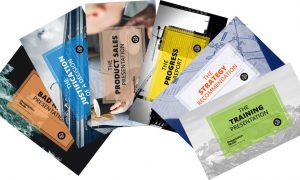The Refreshing Truth About Rehearsing Your Presentation


Everyone has their own view on the usefulness of rehearsing your presentation in advance, and not all of them encourage it. If you’ve ever had to deliver a talk there’s a strong chance you’ve heard one or many of these views. It’s deceptively easy (and tempting) to believe them. But George Torok explains here why these are damaging myths that must be exposed for what they are: presentation saboteurs.
These myths cluster around three main questions:
- Should you rehearse your presentation?
- How should you rehearse?
- What can you expect from rehearsing?
Myth 1: Don’t practise, instead just be natural
This is probably the second most common myth about rehearsing your presentation. (Yes, you’ll read about the most common myth later in this article.)
Why do people believe that rehearsed equates to being unnatural? I believe this is simply an excuse for those who don’t want to prepare. They misinterpret the word ‘natural’ as ‘unprepared’ or ‘sloppy’.
The reality is that rehearsed means better prepared. When you’re better prepared you will feel and appear more confident. When you appear more confident your presentation will look more natural and you will be more effective.
Be sure to practise your presentation
Myth 2: If you’re good, you don’t need to practise
This might be a balm for the fragile ego of presenters who believe they’re good enough. Perhaps they’ve been told they are good. Maybe they are, but is that any reason to risk a poor performance?
Pick a sport. The team or individual wins because they practise. When it’s time to compete for the top prize, they practise even more because they want that winning edge that comes from diligent practice.
I’m a professional speaker and presentation skills expert. I’ve been working in this field for over 20 years. You can bet that I’m good, yet I still plan and prepare for every presentation. I don’t want the risk that the next one is the time that I bomb. My clients expect my best. When you present, your audience expects to see your best.
It doesn’t matter how good you believe you are – practise
Myth 3: You don’t need to practise if you know your topic
This placebo assumes that a successful presentation only requires that the presenter is knowledgeable on the topic.
Knowledge of the topic is the entry fee. What value is there in listening to a speaker who isn’t knowledgeable on the topic? If that’s what the audience wanted they could have visited the local pub and listened to any loud mouth expound their opinions on the topic.
Knowing the topic doesn’t get you excused from practice. Knowledge will help you prepare your content. That’s only one piece of the puzzle. You also need to develop your structure and rehearse your delivery.
A common mistake of unrehearsed knowledgeable presenters is to deliver too much information. This will bore and annoy the audience. Rehearsal will help you prioritize the information and clarify the relevance for the audience.
Know your topic, organize your material and rehearse your delivery
Myth 4: There’s no time to practise
This is a feeble excuse. If you don’t have time to prepare – you don’t have time to present. You either make time to prepare before your presentation or you waste time afterwards analyzing what went wrong.
If you are often asked to present without adequate notice, then be prepared by rehearsing before you need to rehearse. Be like the firefighters who practise before the fire starts.
Don’t rehearse your presentation before your audience.
Demonstrate your respect for the audience by delivering your well-rehearsed presentation to them
Myth 5: Rehearse your presentation while traveling to the meeting
You recognize that you need to rehearse your presentation but you’re not going to give it the attention it deserves. Instead, you’ll fake the rehearsal while travelling.
What does that look like? If you’re commuting on the train, bus or subway that suggests that you’ll annoy your neighbouring commuters. Or do you plan to mouth the words while gesturing wildly? Reading your words silently might help you get more comfortable with the text but there’s a significant difference between reading silently and speaking the words. You will probably think the words perfectly but you might encounter problems when you attempt to speak the words.
Perhaps you plan to rehearse in the car while driving to the meeting. At least your speaking won’t annoy the other drivers. But, how effective will the rehearsal be? You need to concentrate on the driving therefore you can only allow limited attention to the presentation.
Rehearsing on the way to the event is too late. In fact, it’s better to not rehearse on the day of the event because you will tend to be too nervous. The only practice you might perform on the day of the event is to review your opening and closing lines.
You need to rehearse your presentation at least a day or more before the real event. That gives you time to make changes and for the desired delivery patterns to become familiar. It’s best to rehearse in the manner you will deliver the presentation. That means, if you will deliver it while standing, you should rehearse the presentation standing. Ideally, you want to rehearse in the same room of the presentation. That’s not always possible. Do your best to simulate that environment for your rehearsal.
Rehearse your presentation before the journey to the venue
Myth 6: Too much practice will make you appear robotic
Production robots don’t look like humans. The robots are tools. It might look like a mechanical arm that moves material repeatedly on a production line. It could be a welder that consistently performs the same boring task a hundred times a day without deviation, question or emotion. Those three qualities make a robot valuable.
People might fear that repeated rehearsal will make their performance appear robotic. That happens when they focus entirely on the task and ignore the relevance while flat-lining their emotions.
It’s not too much practice that kills a performance. It’s that the person loses interest, energy and direction. A great piano player will practise their scales repeatedly. But he will only benefit if he imagines every practice as a master performance.
Practise. Be in the moment. Visualize the audience before you. Recognize the relevance of your message. Express your emotion every time.
Myth 7: Practise your presentation from start to finish
You’ve decided to practise and you recite from the beginning to end. Perhaps you even repeat it once or twice. That’s not good enough.
It can be more productive to rehearse your presentation in pieces
Work on your opening a few times, then your closing, followed by key sections within the body. Rehearse your transitions. By breaking the presentation into pieces, it’s easier to remember and you can spend more emphasis on the more important parts. Don’t assume that everything you say is equally important.
Myth 8: You don’t need to practise your answers to questions
If you plan to answer questions, how you do that is also an important part of your presentation. The audience will judge you on how you answer the questions. Don’t leave that to chance. Rehearse your answers to the easy questions and rehearse the answers to the difficult questions. The difficult questions are the ones that you hope they don’t ask. After you rehearse your answers to tough questions, you’ll be hoping that they ask those questions.
The way you handle that tough question could be the deciding moment for the audience
Myth 9: Practice makes perfect
This is the most common myth about practice. If there was any doubt about the need to rehearse, by now you probably understand the need to rehearse your presentation.
The mistake at this point is to fall into the trap that “practice makes perfect”. You’ve probably read or heard this pithy expression many times. When we hear a phrase repeatedly, we tend to believe it. I’m urging you, don’t believe this expression.
Why? Two reasons.
One, there are very few cases where this phrase applies. You might score a ten in a gymnastics routine or get a 100% on your test. But you won’t deliver a perfect presentation. The minor flaws help to make it appear real, just like a real diamond.
Two, perfection is the wrong goal for a presentation. If that’s your goal, you’ll fail every time. Instead your goal is to deliver an effective presentation, one that moves your audience to act in the way desired.
If you’re speaking, it’s important. If it’s important you want to deliver a successful presentation. A presentation is a performance. A successful performance follows preparation and rehearsal.
If you want to win, rehearse – no excuses
If you like this, you might also like
All our other great articles on rehearsing and practising your speech.














Paul Houle
30th May 2018 at 3:29 pm
George, a wonderfully well-written piece and true, true, true. As someone who has spent most of my life as a professional musician, and the last 20 as a speaker, I have always found a lot of similarity between the two. While I can get up on stage and improvise for you on my instrument and sound extremely competent if I rehearse something I’m playing I can just “kill” it. ( musician lingo for an outstanding performance).
The confidence and attitude of how you play a note is much different when you are well prepared versus winging it, the same goes for speaking.
Well done.
George Torok
31st May 2018 at 2:34 pm
Paul, appreciate your insight and perspective as a professional musician.
My musical “career” lasted through my high school years – in the school band. Perhaps that’s where I learned the value of practice.
Sandra Zimmer
21st June 2018 at 4:25 am
Hello George, I’d like to add a little to the idea of practicing in segments. I was an actress who became a speech coach about 30 years ago. Actors rehearse in scenes, short segments of the play, before they practice the whole play. Likewise, I encourage my clients to break their talk into short chunks and to practice a chunk at a time. Practicing one chunk several times in a row helps you learn that chunk. Once you have practiced all the chunks individually, you can start putting them together to rehearse the whole talk. This approach requires several days or even weeks of practice, but the reward is the ability to deliver a talk that you really know, just like actors know their play. As you said in Myth 6, you have to be fully involved with your material each time you practice. That way you are rehearsing the emotional aspects of your talk as well as the words. Thanks for busting some myths about practicing speeches and presentations!